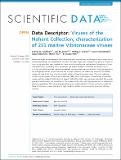Viruses of the Nahant Collection, characterization of 251 marine Vibrionaceae viruses
Author(s)
Brown, Julia M.; Kelly, Libusha; Kauffman, Anne Kathryn Marie; Sharma, Radhey Shyam; VanInsberghe, David Stephen; Elsherbini, Joseph Ahmed; Polz, Martin F; ... Show more Show less
Downloadsdata2018114.pdf (1.643Mb)
PUBLISHER_CC
Publisher with Creative Commons License
Creative Commons Attribution
Terms of use
Metadata
Show full item recordAbstract
Viruses are highly discriminating in their interactions with host cells and are thought to play a major role in maintaining diversity of environmental microbes. However, large-scale ecological and genomic studies of co-occurring virus-host pairs, required to characterize the mechanistic and genomic foundations of virus-host interactions, are lacking. Here, we present the largest dataset of cultivated and sequenced co-occurring virus-host pairs that captures ecologically representative fine-scale diversity. Using the ubiquitous and ecologically diverse marine Vibrionaceae as a host platform, we isolate and sequence 251 dsDNA viruses and their hosts from three time points within a 93-day time-series study. The virus collection includes representatives of the three Caudovirales tailed virus morphotypes, a novel family of nontailed viruses, and the smallest (10,046 bp) and largest (348,911 bp) Vibrio virus genomes described. We provide general characterization and annotation of the viruses and describe read-mapping protocols to standardize genome presentation. The rich ecological and genomic contextualization of hosts and viruses make the Nahant Collection a unique platform for high-resolution studies of environmental virus-host infection networks.
Date issued
2018-07Department
Massachusetts Institute of Technology. Department of Biology; Massachusetts Institute of Technology. Department of Civil and Environmental EngineeringJournal
Scientific Data
Publisher
Scientific Data
Citation
Kauffman, Kathryn M., et al. “Viruses of the Nahant Collection, Characterization of 251 Marine Vibrionaceae Viruses.” Scientific Data, vol. 5, July 2018, p. 180114. © The Author(s) 2018.
Version: Final published version
ISSN
2052-4463